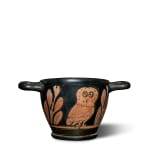South Italian
A Greek red-figure owl skyphos, South Italy, circa 4th century BC
Pottery
Height: 7.8 cm; diameter: 15.5 cm
Each side of the vase depicts an owl facing right, framed by laurel sprigs.
Condition: Intact. Minor cracking in the glaze and tiny chips to the rim.
Each side of the vase depicts an owl facing right, framed by laurel sprigs.
Condition: Intact. Minor cracking in the glaze and tiny chips to the rim.
Condition: Intact. Minor cracking in the glaze and tiny chips to the rim.
Provenance
With Charles Ede, London, 1992Private collection, California, USA, acquired from the above in 1992
Literature
The owl in Ancient Greek art began to acquire its popularity in Attica from the mid 6th century BC, and by the late 6th century the bird had firmly become the goddess Athena’s cherished companion. It was believed that the owl had apotropaic powers against the evil eye, as well as being a symbol of good fortune and wisdom.Owl skyphoi were produced in the 5th and 4th centuries in Athens and then in Southern Italy; they have been found across the Mediterranean. The little vessels became so popular that they were given their own name, a ‘glaux’ (meaning owl).
Attic vases including owl skyphoi were exported in large numbers to the Greek colonies of South Italy who wanted a taste of home in their luxury objects. Soon the local vase-painters of South Italy began to make their own versions and this is just such an example.



